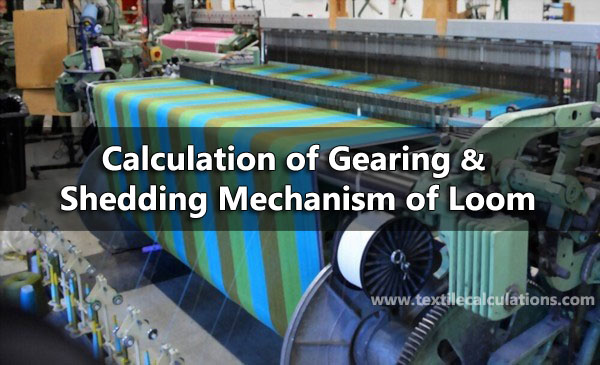Introduction:
Shedding is the first primary motion of the loom motions. Dividing of warp threads into two parts for insertion of weft thread is called shed, and the mechanism to form shed is called shedding. There are two types of shedding – 1) Positive shedding and 2) Negative shedding. Basic shedding mechanisms are Paddle/treadle, Tappet, Dobby and Jacquard. Each mechanism has different characteristics, benefits and limitations. So, calculations play an important role in shedding process. Some important calculation (Crank Shaft RPM, Counter Shaft RPM, Bottom Shaft RPM, PPM, Machine RPM, Production of Loom, Driver or Driven Shaft RPM etc.) of gearing and shedding mechanism of a loom are discussed below.

Calculation of Gearing and Shedding Mechanism of Loom:
1. Find the RPM of bottom shaft, counter shaft and PPM from the following data-
RPM of Crank Shaft = 600
Picks to the round = 4
Solution:
We know,
PPM (Picks Per Minute) = RPM of Crank Shaft
So, PPM = 600 (Ans)
…………………………………………PPM
RPM of Counter Shaft = ————————
…………………………………No of Tappets
Given, Picks to the round = No of tappets = 4
………………………………………600
So, RPM of counter shaft = ———- = 150 (Ans)
………………………………………..4
Again, we know that,
…RPM of Crank Shaft 2
———————————– = ———–
…RPM of Bottom Shaft 1
………………………………………RPM of Crank Shaft
Or, RPM of Bottom shaft = —————————————
……………………………………………………2
….600
= ————-
…..2
= 300 (Ans)
2. Find out the PPM of the loom from following information-
- Motor RPM = 800
- Motor Pulley Dia = 3”
- M/C Pulley Dia = 8”
- No of Tappet = 4
- RPM of Counter Shaft = 75
- Crank Shaft Wheel = 74T
Solution:
We Know,
…………………………………………..PPM
RPM of Counter Shaft = —————————–
…………………………………….No of Tappets
So, PPM = RPM of Counter Shaft x No of Tappets
= 75 x 4
= 300
RPM of Crank Shaft = 300 (Ans)
3. Find the production per hour of a loom in which the auxiliary shaft is running at 50 rpm and there are 4 picks to the round.
Assume,
PPI = 40 and
Efficiency = 90%
Solution:
We Know that,
…………………………………………..PPM
RPM of Counter Shaft = —————————
……………………………………No of Tappets
So, PPM = RPM of Counter Shaft x No of Tappets
= 50 x 4
= 200
……………………………………….PPM
So, Production of loom = ————— x Efficiency
……………………………………….PPI
….200 90
= ——– x ————– inch/min
….40 100
….200 x 90 x 60
= —————————- yds/hr
….40 x 100 x 36
= 7.5 yds/hr (Ans)
4. Find RPM of bottom shaft, crank shaft and PPM from the following data-
No of teeth in crank shaft = 48T
RPM of counter shaft = 75
No of tappets = 4
Solution:
We know,
……………………………………………PPM
RPM of Counter Shaft = ————————–
…………………………………….No of Tappets
So, PPM = RPM of Counter Shaft x No of Tappets
= 75 x 4
= 300
So, RPM of crank shaft = 300 (Ans)
…RPM of Crank Shaft 2
———————————- = ————-
…RPM of Bottom Shaft 1
……………………………………..RPM of Crank Shaft
Or, RPM of Bottom shaft = ——————————
………………………………………………….2
….300
= ————-
…..2
= 150 (Ans)
5. Tabulate the speed of crank, bottom and auxiliary shafts for a loom running at 200 PPM having four tappets on the auxiliary shaft.
Solution:
Here Given,
PPM = 200
So, Crank shaft speed = 200 rpm (Ans)
……………………………………..RPM of Crank Shaft
Or, RPM of Bottom shaft = ——————————–
………………………………………………….2
…200
= ————-
….2
= 100 (Ans)
………………………………………..PPM
RPM of Counter Shaft = ————————–[Counter Shaft = Auxiliary Shaft]
…………………………………No of Tappets
…200
= ———-
….4
So, RPM of auxiliary shaft = 50 (Ans)
6. Find out the rpm of the loom from the following information-
- Motor RPM = 950
- Motor Pulley Dia = 3”
- Machine Pulley Dia = 8”
- Crank Shaft Wheel = 37 T
- Bottom Shaft Wheel = 74T
Solution:
We know that,
………………………………………………Motor Pulley Dia No of Teeth of Crank Shaft Wheel
Loom RPM = PPM = Motor RPM x —————————— x —————————————————
…………………………………………….Machine Pulley Dia No of Teeth of Bottom Shaft Wheel
…………….3 37
= 950 x ——– x ———
……………8 74
= 178.125 (Ans)
7. Find out the PPM of loom from the following information –
- Motor RPM = 1440
- Motor Pulley Dia = 3”
- Machine Pulley Dia = 8”
Solution:
…………………………………Motor Pulley Dia
PPM = Motor RPM x ———————————-
………………………………Machine Pulley Dia
………………3
= 1440 x ———-
………………8
= 540 (Ans)
8. A wheel of 80 teeth fixed on a shaft of 120 rpm drives a wheel of 50 teeth. Find the speed of the shaft on which the driven wheel is fixed.
Solution:
Here given,
- Driver Shaft RPM = 120
- Driver Shaft Wheel Teeth = 80 T
- Driven Shaft Wheel Teeth = 50 T
- Driven Shaft RPM =?
…………………………………………………………..Driver Wheel Teeth
Driven Shaft RPM = Driver Shaft RPM x —————————————
………………………………………………………….Driven Wheel Teeth
……………80
= 120 x ——- = 192 (Ans)
……………50
Conclusion
I have tried to explain/show all the calculation of Gearing and Shedding mechanism of a Loom in weaving mill with so many examples through this article. Hope this article will be helpful for those who are new to the Weaving mill or those who are students.
Author of this Article:
Md. Imran Hossain
B.Sc. in Textile Engineering
Shahid Abdur Rab Serniabat Textile Engineering College, Barisal.
Email: [email protected]
You may also like:
